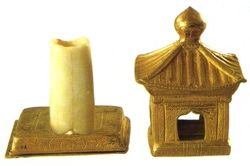|
Eighty thousand pieces of relics (Sarira in Sanskrit) were left after
the death and cremation (Parinirvana in Sanskrit is a Buddhist term)
of Shakyamuni Buddha.
In 259 B.C., King Asoka united the neighboring countries, and declared
to adopt Buddhism as the national religion. He convened the Third Council
in the history of Buddhism to collect, edit and publish all Buddha's
teachings, i.e. Tripataka. He also decided to open the Mahaparinirvana
Hall and take out the relics of Shakyamuni Buddha. King Asoka then distributed
the eighty four thousand relics to different areas within and without
the country to disseminate Buddhism in the whole wide world.
 In
240 B.C., a group of 18 monks (Samana in Sanskrit) and followers carried
19 parts of relics to China. During their journey, Buddha in his spiritual
form told them that they had to keep the relics hidden, and only to
reveal them later when Chinese people would have accepted Buddhism.
The monks then followed the instruction and buried the relics in a 'sacred
tomb'. In
240 B.C., a group of 18 monks (Samana in Sanskrit) and followers carried
19 parts of relics to China. During their journey, Buddha in his spiritual
form told them that they had to keep the relics hidden, and only to
reveal them later when Chinese people would have accepted Buddhism.
The monks then followed the instruction and buried the relics in a 'sacred
tomb'.
They arrived at Chang-an and visited Emperor Chin. Unfortunately, they
were accused of 'confusing people and conspiring riots' and were jailed.
The government burnt all the sutras and disposed of them like garbage.
Later, a heavenly general (Vajra in Sanskrit) broke into the prison
and rescued the 18 people. They decided to split into four groups, and
preached Buddhism secretly in four directions with the capital Chang-an
as the centre. They also agreed to meet together every year in the 'sacred
tomb' on the 8th of April, i.e. the birthday of Shakyamuni Buddha. They
reported, exchanged and shared their experience in preaching.
 While
they did not have the sutras, they could only taught and transmitted
Buddhism by word of mouth. With their death, Buddhism was unable to
gain a solid footing in China. Their will could only be achieved and
realized several hundred years after. While
they did not have the sutras, they could only taught and transmitted
Buddhism by word of mouth. With their death, Buddhism was unable to
gain a solid footing in China. Their will could only be achieved and
realized several hundred years after.
In 64 A.D., Emperor Ming of Han Dynasty had a wonderful dream, which
was interpreted as auspicious one. Based on his dream, he ordered his
officers to seek for the Indian monks in the west. It was almost two
years before they met two monks in Kusha. They were Kashyapamtanga and
Dharmaraksha, who rode on white horses carrying the portrait of Shakyamuni
Buddha and the Sutra of Forty-two Chapters. They were cordially invited
to settle in Lo-yang. Emperor Ming built a temple for them to teach
him Buddhist doctrines, and to translate the sutras into Chinese. It
was officially regarded as the beginning of Buddhism in China.
In 148 A.D., another monk called An Shih-kao from An-hsi went to China.
He saw colorful flashes of light in an abandoned graveyard on the way
and immediately reported to the Emperor, who asked people to explore
and dig in the graveyard. Within half a day, they found eight pieces
of tiles with Sanskrit scriptures written by the 18 people. More importantly,
the scripture indicated that 19 pieces of relics were buried 3 feet
under the tiles. An Shih-kao brought the relics to the Emperor in Lo-yang,
who intended to build a stupa to keep the relics in the palace.
 However,
An Shih-kao requested the Emperor to keep these relics in different
areas, so that Buddhism could spread rapidly in China. With the consent
of the Emperor, a four-storey stupa was built where the relics were
originally found. The Buddha finger, the largest piece of the relics,
was kept in a golden vase in the underground palace in the stupa. After
the stupa was built, a grand temple called King Asoka Temple, now Fa-mun
Temple, was erected next to it. Another 18 stupas were built for the
rest of relics in other areas in China. However,
An Shih-kao requested the Emperor to keep these relics in different
areas, so that Buddhism could spread rapidly in China. With the consent
of the Emperor, a four-storey stupa was built where the relics were
originally found. The Buddha finger, the largest piece of the relics,
was kept in a golden vase in the underground palace in the stupa. After
the stupa was built, a grand temple called King Asoka Temple, now Fa-mun
Temple, was erected next to it. Another 18 stupas were built for the
rest of relics in other areas in China.
As clearly recorded in history, the Finger Sarira is so rare that it
was welcomed and worshipped by seven emperors in Tang Dynasty, and other
emperors in other dynasties. It is certainly the most respected and
precious sacred treasure in Buddhism, representing the body of Shakyamuni
Buddha.
Because of the Finger Sarira, Fa-mun Temple was regarded as the 'royal'
temple in Tang Dynasty. In 1987, The Finger Sarira was revealed in Fa-mun
Temple on the birthday of Shakyamuni Buddha. It attracted the attention
of the people around the world, who start focusing on Fa-mun Temple
again.
|

